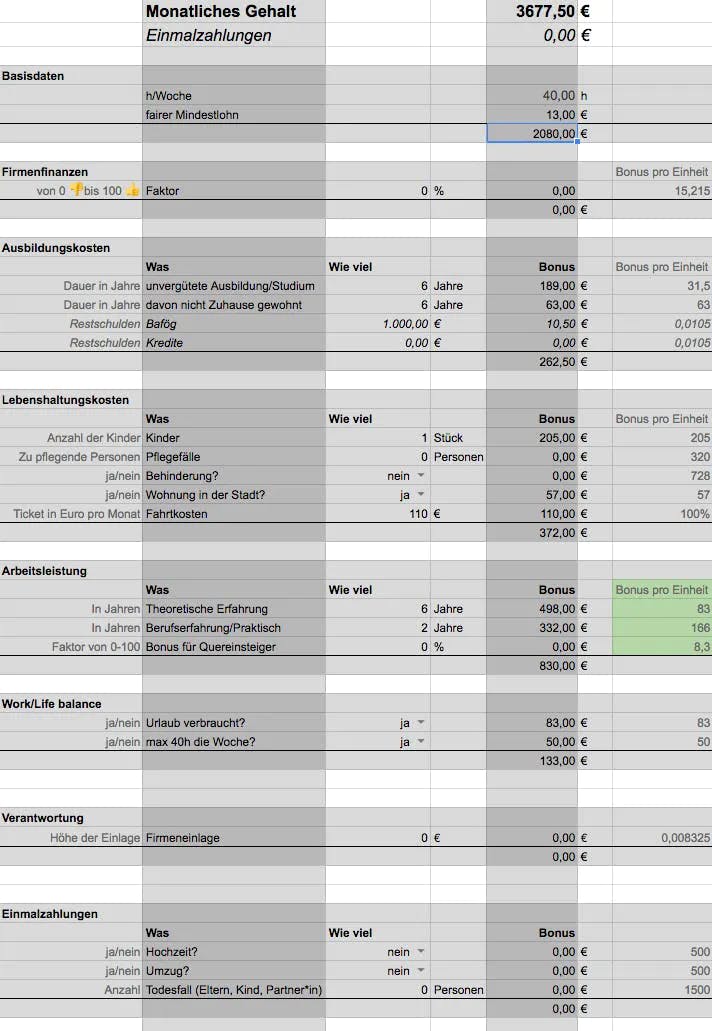At farbenmeer, we are constantly reflecting on how we work and questioning why we choose a particular path to solve a problem. With salaries, we asked ourselves: how is our pay actually composed?
Right now, all farbenmeer colleagues receive roughly the same net salary transferred to their bank account. But is that fair? What about people who only want to work part‑time, or people who are fresh out of school and need much attention until they’ve found their footing in everyday working life? Or people with special needs, e.g. with children, long commutes, disabilities. Treat everyone the same? We asked ourselves how all of this can be reflected in a salary.
Is it fair to pay different salaries for the same work?
The capitalist answers this question with a clear yes—because someone with many years of experience can solve a task much faster, handle more tasks, and generate more revenue in the same period than a newcomer to the field.
The socialist answers no—because the work effort of the individual is the same. The newcomer also works 40 hours a week on their tasks and solves them to the best of their knowledge as quickly as they possibly can.
Which of these two approaches is fair?
Both! Because, on one hand, we live in a capitalist market economy. That means we have to create added value—value someone is willing to pay for. This added value must be of sufficient quality or quantity that it covers the cost of acquiring further value. People who create a lot of added value for others therefore also have the right to demand a lot of value in return from others.
For example: Max creates many websites for the general public (the market), and thus he is also entitled to take from the general public (e.g. buy food from the farmer) in the same measure.
On the other hand, we also live in a democratic welfare state. Human dignity is inviolable—we agreed on that more than 60 years ago. Aside from funding issues, we want to enable everyone to live a dignified life. It doesn’t matter whether the person contributes to society or whether they physically or mentally are able to do so. A person should receive enough resources to be physically and mentally healthy and able to fill their life with meaning.
From these two perspectives, two financial factors can be derived for a fair salary: costs & benefits. That might sound like business administration, but it is not quite that in our case. Because we view this from the individual’s perspective, not the company’s:
Costs: What does a single person need to live a life with meaning?
Benefit: How much added value can a single person create?
How to build a salary from this insight
Option 1 – Evaluation Matrix
By breaking down costs and benefits into measurable items. From our attempt to list the costs and benefits of one person in measurable terms, we developed a matrix with several building blocks.

Costs
It starts with ensuring existence: a base value for all the costs every person needs for a dignified life, meaning food, shelter, cultural participation, etc. Then come separately listed expenses: cost of living and education costs.
Someone who has studied and lived away from home had high expenses, even high loans, which need to be repaid. It’s fair that this advanced expense can be covered again by salary. Cost of living includes recurring expenses that represent extraordinary extra effort. For example, having a child is a high financial and mental burden, which justifies that such a person may consume more resources—i.e. get more money—because their ability to produce value that can be sold is diminished, since their child requires more time and money.
Benefit
How much added value can a person create within the company? Work performance is decisive here. It is measured by how long the person has been working in the profession. The assumption is that more experience results in more efficient work performance. In the matrix, practical experience is rated more highly than theoretical experience, since knowledge has already been applied in real settings and real everyday problems have had to be solved.
After discussing this matrix at farbenmeer, we were all convinced it would be useful for calculating a fair salary. Some numbers needed tweaking, and some special cases needed to be included. Overall, we found this approach very valuable because it is a method to tailor a salary individually to each person’s needs.
Disadvantages
Right after the discussion, everyone started inputting their parameters into the matrix, and it quickly became clear that the salaries would diverge widely. One colleague even discovered their salary would become lower than it currently is. A no‑go for everyone, because we absolutely didn’t want to cut salaries without a serious reason. So we had to adjust parameters again. Should we simply raise the “minimum salary”? But then the other salaries also go higher, so the pay gap remains. Maybe adjust bonuses proportionally so that increases per child, for example, are smaller. Also, have bonus increases flatten out the more years of experience someone has, because at some point there’s no further productivity gain from experience—maybe a sigmoid function?! … It becomes complex!
Advantages
There is a uniform and deterministic function by which everything can be determined individually. A matrix that calculates them all!
Option 2 – Keep everything as it is

We stick to everyone earning the same. We keep the socialist approach that everybody invests the same life‑time, and thus should earn the same, even if it means some people produce greater added value for customers in order to help support those who produce less added value in comparison.
Disadvantage
The salary scale can be increased depending on revenue, but only equally for everyone. Special needs are not considered. Someone who spends €200 per month on public transport gets exactly the same salary as someone who lives right next to the office. That is not very fair.
Advantage
The salaries are very easy to follow and simple to implement.
Option 3 – Let the Market Decide
We do it like everybody else: let the market—or the individual’s negotiation skill—decide. That means the salary is set only as high as needed to attract people who meet our requirements for that amount.
Disadvantage
Money becomes the centre of the work. Our colleagues either live at subsistence level or leave farbenmeer for a firm that throws money at them but where they may be culturally dissatisfied.
Advantage
Maximum profit for the company.
Option 4 – Everyone Chooses Their Own Salary
Everyone determines their own salary. This idea sounds crazy at first glance. The first thought: everyone would just set an utopian high salary. But with a company culture where everyone is part of the company, everyone is allowed to make decisions, and there is no boss, it must be seen differently. At farbenmeer, all finances are transparent to everyone. We know what we earn, what we spend, and what our colleagues earn. Each of us has an interest that the company lives long and successfully, and thus no one will enrich themselves at the expense of everyone else. To ensure this can’t happen, everyone must be informed about any salary decision. Also, every team member has the opportunity to object and sit down with the colleague again. This ensures that everyone has to justify their decision and listens to other perspectives.
Disadvantage
Reserved people may be disadvantaged compared to confident ones because they may not voice their needs.
Advantage
Everyone can adjust their salary to their needs, and must justify why they should earn more than others face‑to‑face. Through transparency everyone knows how high their salary is compared to others and what is financially possible for the company. So in private emergencies a salary can be increased, and if someone wins the lottery maybe suspended for a while.
Conclusion
None of the four methods offers THE solution that can apply to every company. A self‑chosen salary is very unrealistic in a global corporation where a manager is so far removed from a line worker that they don’t even know what their daily work is. With a mixture of resentment and exhaustion the disconnected in such a company would set their salaries so high that the financial condition of the company would quickly reverse. So it’s important that company culture is aligned with the method.
At farbenmeer, we have decided that everyone can determine their own salary. We don’t want a matrix so complex that nobody can follow it, or which must be often modified for specific conditions or doesn’t account for many cases.
We will need to ensure that our colleagues actually take advantage of this possibility and use it when they deem it necessary.
We are excited to try this out, and will share a “lessons learned” update as soon as we've gathered enough experience.
